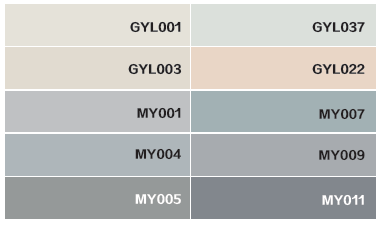
Microcement artistic coating is composed of special cement, water-based resins, pigments and fillers, etc. It features strong plasticity, antibacterial and mildew resistance, easy cleaning, good hardness, high strength, and water-based environmental friendliness. It is suitable for application spaces such as schools, hospitals, hotels, museums, fully renovated apartments, old house renovations, and public buildings.

Microcement Artistic Coating
- Product Features
- Unique Texture: Utilizes microcement technology to create a natural, realistic stone texture with a mottled appearance. It conveys a sense of rustic simplicity and Zen aesthetics.
- Superior Performance: Offers excellent water resistance, alkali resistance, and stain resistance, effectively withstanding environmental impacts and extending its service life.
- Environmental Friendliness: Features anti-formaldehyde properties, meeting the requirements for eco-friendly living spaces.
- Sound Insulation: Provides a certain level of soundproofing, creating a quiet and comfortable environment.
- Application Scenarios: Suitable for home spaces that pursue personalization and artistic appeal, such as living rooms, bedrooms, and studies, as well as for commercial space decoration.
Regular Paint
- Product Features
- Environmental Performance: Contains bamboo charcoal factors and other components, offering efficient odor reduction and safe mildew resistance.
- Diverse Functions: Equipped with antibacterial, mildew-resistant, odor-reducing, and high-covering capabilities.
- Rich Colors: Available in a wide range of colors to meet personalized needs.
- Application Scenarios: Applicable to various indoor venues such as homes, schools, hospitals, and offices for wall decoration.
Summary
Microcement artistic coating and regular paint each have their own strengths. Microcement artistic coating is suitable for consumers who pursue personalization and artistic appeal, adding a unique texture to living spaces. Regular paint, on the other hand, excels in environmental performance and diverse functions, making it suitable for a broader range of decoration scenarios and needs.
Refer to the construction process. For specific operations, please follow the instructions in the manual.
| Step | Operation | Notes |
|---|---|---|
| Surface Preparation | Clean the surface, removing dust, grease, old paint, and other impurities. Repair cracks and holes, and sand the surface smooth. | Ensure the surface is dry, flat, and free from loose particles. |
| Primer Application | Apply primer evenly. Allow the primer to dry (usually 24 hours). | Ensure the primer fully covers the surface and avoid any missed areas. |
| Artistic Paint Application | Mix the artistic paint as per instructions and apply the first coat evenly with a trowel or spatula. Create textures on the semi-dry surface. Apply the second coat of artistic paint to enhance texture and thickness. | Create textures evenly and naturally, avoiding overlaps. |
| Topcoat Application | Apply a clear topcoat (optional). Use a sponge or roller to refine the texture (optional). | Apply the topcoat evenly and avoid sagging. |
| Curing | Protect the surface from collisions and contamination. Keep the area ventilated and allow it to dry naturally (usually 7 days). | Avoid contact with water and chemicals during the curing period. |
